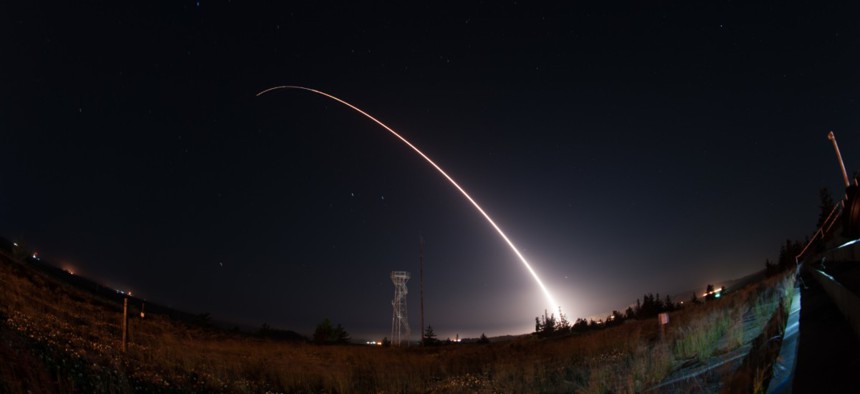Nuclear Security Agency Turns to $600M Supercomputer for Weapons Readiness and Advancements

An unarmed Minuteman III intercontinental ballistic missile launches during an operational test in 2017. Michael Peterson/Air Force
Cray will build El Capitan, an exascale high-performance supercomputer, to manage the nation’s nuclear stockpile.
The National Nuclear Security Administration will gain its first exascale high-performance supercomputer—El Capitan—in late 2022, officials announced Tuesday.
Built by Cray, Inc. for the Energy Department’s Lawrence Livermore National Laboratory, the system will support NNSA as it ensures America’s nuclear weapons are secure and reliable in the absence of underground testing. The contract is valued at nearly $600 million and marks the third exascale computer Cray will build for the government, having previously announced Argonne National Lab’s Aurora and Oak Ridge National Lab’s Frontier.
“As our deterrent continues to age well beyond its designed lifetime and the threat environment we face rapidly changes, the capability represented by El Capitan is essential to national security,” Director at LLNL Bill Goldstein said on a call with reporters ahead of the official announcement. “It will get us answers about the nuclear stockpile more accurately and more quickly than ever before.”
Established by Congress in 2000, NNSA works to enhance national security through the military application of nuclear science, protect nation’s nuclear weapon stockpile and reduce the threat of nuclear proliferation and nuclear terrorism around the world. El Capitan will serve NNSA’s Stockpile Stewardship Program through performing bleeding-edge research and calculations to support nuclear advancements.
The system will also be employed to make crucial assessments necessary for addressing national and nuclear threats.
“El Capitan will strengthen U.S. national security, as well as the effectiveness and credibility of our nuclear deterrent which reassures our friends and allies and serves to maintain strategic stability in an increasingly unstable international environment,” Lisa Gordon-Hagerty, undersecretary for nuclear security and NNSA administrator said on the call.
The system will use a newly unveiled software platform from Cray that fuses supercomputing performance with the ease of cloud computing. It will provide new and faster 3D simulation and modeling capabilities. It will also offer advanced computational tools for scientists and weapon designers to study the use of new materials and components and reduce maintenance, manufacturing and production costs.
Cray’s CEO Pete Ungaro said the system will operate at speeds that are more than seven times faster than the world’s fastest supercomputer. It will have the capacity to run 1.5 quintillion calculations per second. One quintillion has 18 zeros.
“In comparing it to its geological namesake, which is one of the world’s tallest monoliths, the system’s compute blades when laid end to end would scale the peak of El Capitan in Yosemite more than three times,” Ungaro said.
To put the number of calculations the system will be able to complete into perspective, a press material from Cray also notes that Twitter averages almost 6,000 tweets per day—at that rate, it would take over 8 million years of tweets to reach 1.5 quintillion.
And while the contract aims to boost national security and extend the life of the nation’s current nuclear weapon system, federal officials are also excited about how it could boost the workforce.
“The opportunity to work with such unparalleled scientific capabilities will significantly help our efforts to recruit and retain the world’s most talented minds for our nuclear security enterprise,” Gordon-Hagerty said. “Indeed the marriage of these cutting-edge computing capabilities and our 21st-century workforce will enable America to maintain our scientific and technological preeminence and secure America's competitive edge in energy and national security in an evolving geopolitical environment.”






